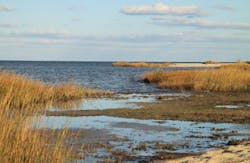Interim report reveals progress in Chesapeake Bay pollution reduction
All of the states that share the jurisdiction of the Chesapeake Bay have made progress in their plans to meet the pollution reduction goals set by the Chesapeake Bay Foundation (CBF) and the Choose Clean Water Coalition (CCWC). However, none of the states are on track to meet all of the pollution protection practices they had agreed to implement by the end of 2013. This is the key finding from an interim report on 2012/2013 milestone goals, conducted by the two organizations.
The 64,000-square-mile Chesapeake Bay watershed is the largest in North America but for many years has also been one of the most polluted. The milestone goals were set for the six watershed states — Virginia, West Virginia, Maryland, Delaware, Pennsylvania and New York — and the District of Columbia, after decades of attempts to cut down on the pollution on their own. The interim report aimed to monitor the progress of each of the jurisdictions and to recommend measures to those that are not on track to meet the goals, the CBF said in a statement.
The report found that, of all the evaluated jurisdictions, Pennsylvania and Delaware fell short on half or more of the milestones. The former, for example, met the milestone mark in three of the eight criteria but lagged behind on the remaining five. According to the CBF, each of the states had the chance to alter their plans so that the 2013 milestones were successfully reached but at present there has been no such information submitted, the statement noted.
By contrast, Maryland excelled in six of the seven criteria. The state had exceeded the goal in animal waste management systems and grass buffers and was firmly on track on cover crops, stormwater retrofits, and wastewater treatment plant and septic system upgrades. The only practice in which Maryland was below its achievement from the previous year was nutrient management plan acreage.
RELATED: Elkton, Md., wastewater treatment plant recognized for optimized performance
Similarly, West Virginia was also on track, with positive results in four of the five practices evaluated. Acres of farms under nutrient management emerged as the most problematic area for West Virginia as well, while it managed to exceed its targets on forest buffers, cover crops and fencing cattle out of streams. Its wastewater treatment plants were right on target to meet this year's milestone goals, the CBF explained.
Each of the states worked out its own blueprint to meet the goals, setting two-year reduction milestones to track progress. States must meet 60 percent of their pollution reduction goals by 2017, and the remainder by 2025. However, the CBF stated that progress for the next set of milestones, due to be set for 2014/2015, should be reported at a county level or at a basin level, rather than as individual states. In order to ensure long-term success of the project the focus should be shifted to local jurisdiction, the CBF and the CCWC commented.
According to Hilary Harp Falk, co-chair of CCWC, it it encouraging that states are working toward their targets and some of them have achieved dramatic progress. However, verification protocols are needed to ensure that proper practices are designed and implemented long-term, she concluded.

